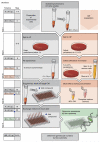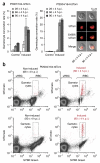An assay to probe Plasmodium falciparum growth, transmission stage formation and early gametocyte development
- PMID: 26134953
- PMCID: PMC4581880
- DOI: 10.1038/nprot.2015.072
An assay to probe Plasmodium falciparum growth, transmission stage formation and early gametocyte development
Abstract
Conversion from asexual proliferation to sexual differentiation initiates the production of the gametocyte, which is the malaria parasite stage required for human-to-mosquito transmission. This protocol describes an assay designed to probe the effect of drugs or other perturbations on asexual replication, sexual conversion and early gametocyte development in the major human malaria parasite Plasmodium falciparum. Synchronized asexually replicating parasites are induced for gametocyte production by the addition of conditioned medium, and they are then exposed to the treatment of interest during sexual commitment or at any subsequent stage of early gametocyte development. Flow cytometry is used to measure asexual proliferation and gametocyte production via DNA dye staining and the gametocyte-specific expression of a fluorescent protein, respectively. This screening approach may be used to identify and evaluate potential transmission-blocking compounds and to further investigate the mechanism of sexual conversion in malaria parasites. The full protocol can be completed in 11 d.
Figures



References
-
- Sowunmi A, Adedeji AA, Gbotosho GO, Fateye BA, Happi TC. Effects of pyrimethamine-sulphadoxine, chloroquine plus chlorpheniramine, and amodiaquine plus pyrimethamine-sulphadoxine on gametocytes during and after treatment of acute, uncomplicated malaria in children. Mem. Inst. Oswaldo Cruz. 2006;101:887–893. - PubMed
-
- Sowunmi A, Fateye BA. Plasmodium falciparum gametocytaemia in Nigerian children: before, during and after treatment with antimalarial drugs. Trop. Med. Int. Health. 2003;8:783–792. - PubMed
-
- Fehintola FA, Balogun ST, Adeoye SB. Intermittent preventive treatment during pregnancy with sulphadoxine-pyrimethamine may promote Plasmodium falciparum gametocytogenesis. Med. Princ. Pract. 2012;21:63–67. - PubMed
-
- Buckling A, Ranford-Cartwright LC, Miles A, Read AF. Chloroquine increases Plasmodium falciparum gametocytogenesis in vitro. Parasitology. 1999;118(Part 4):339–346. - PubMed
Publication types
MeSH terms
Grants and funding
LinkOut - more resources
Full Text Sources
Other Literature Sources

